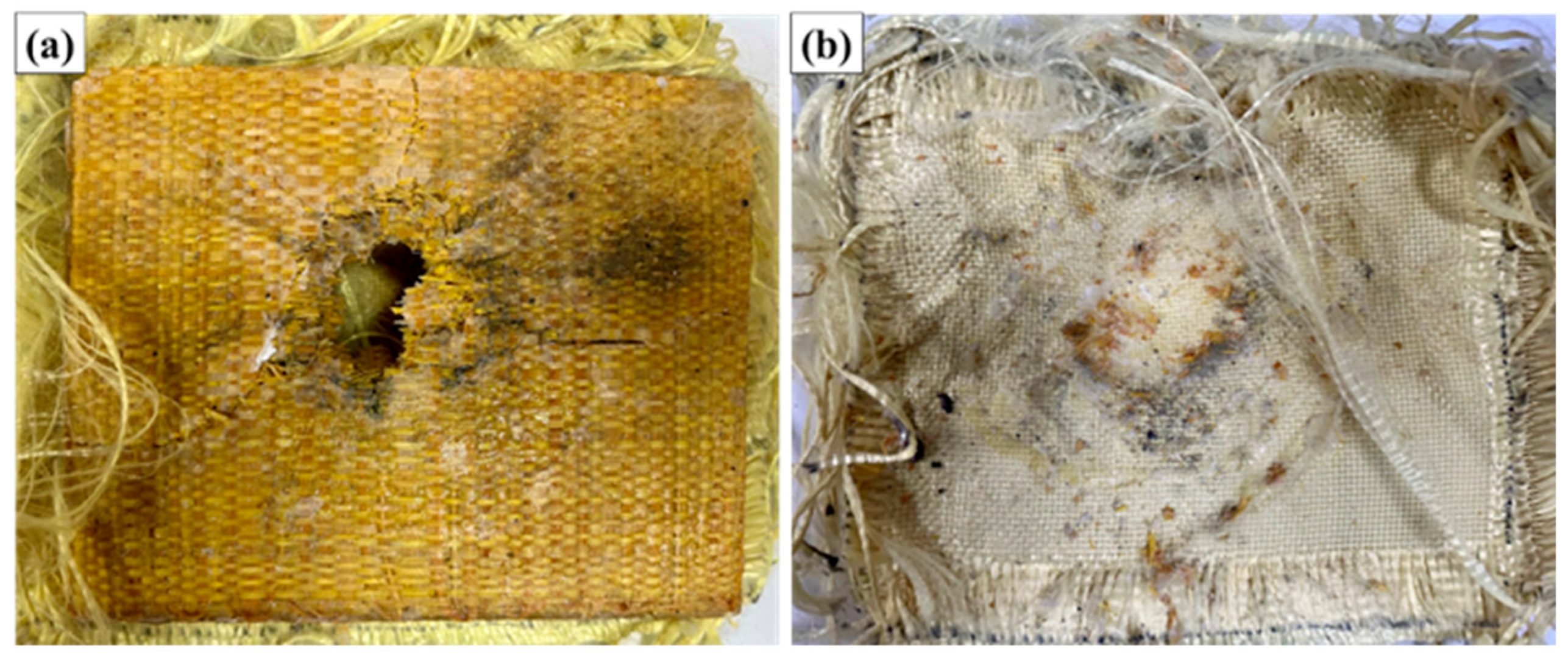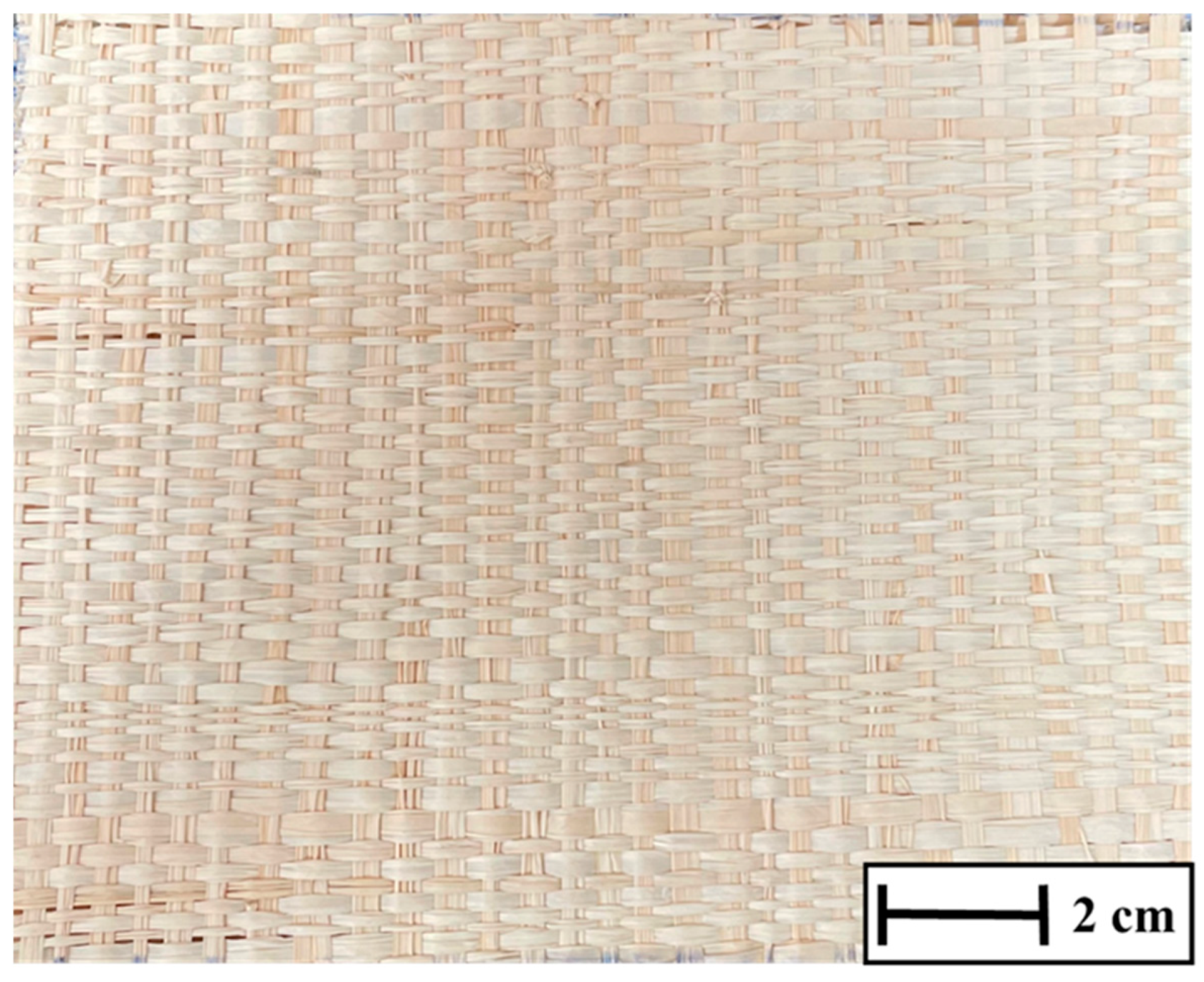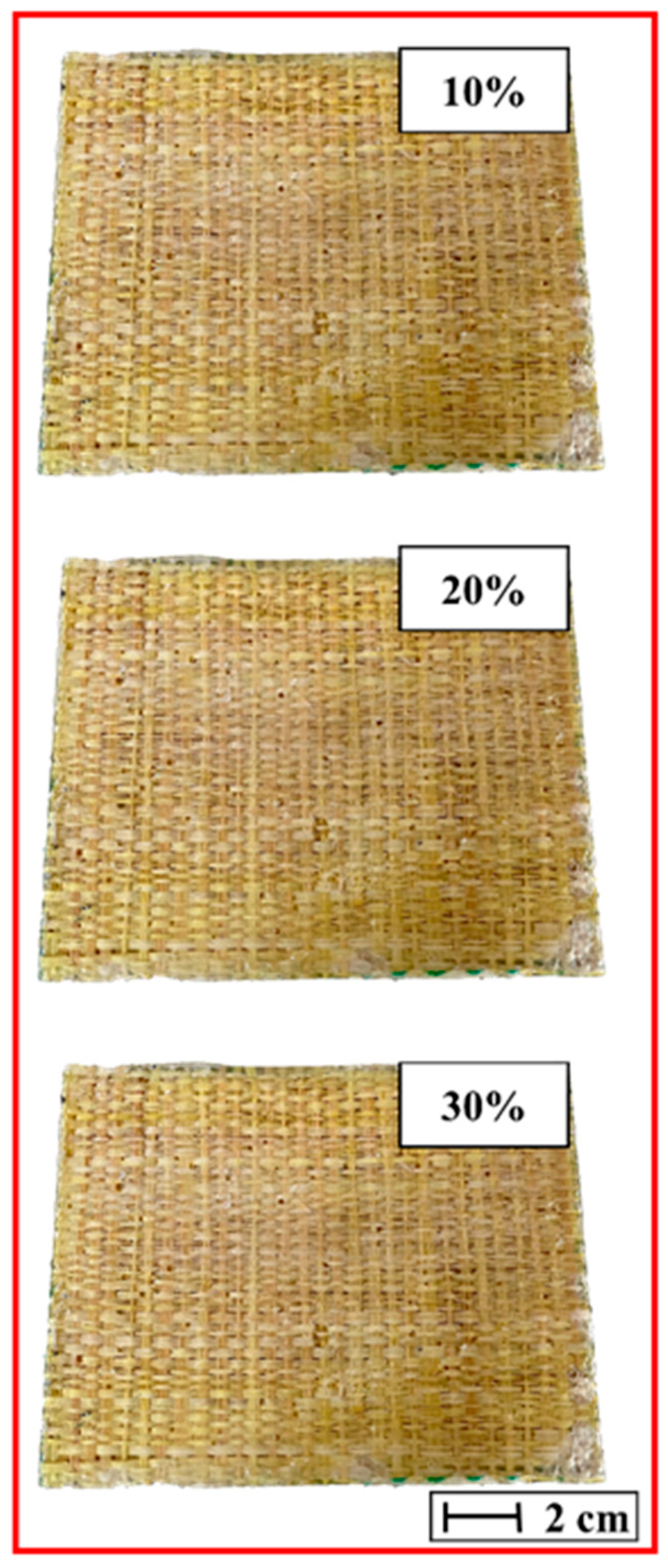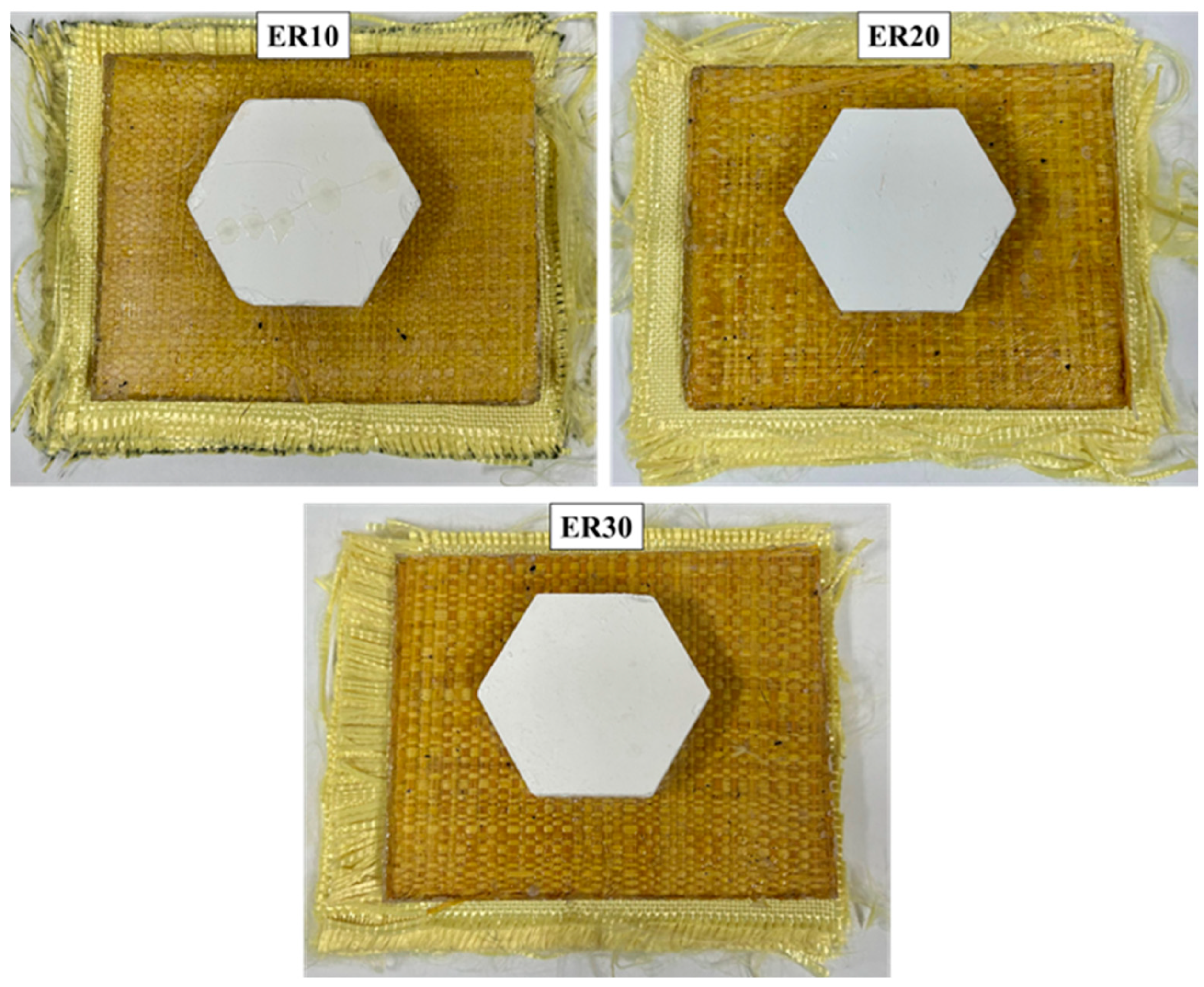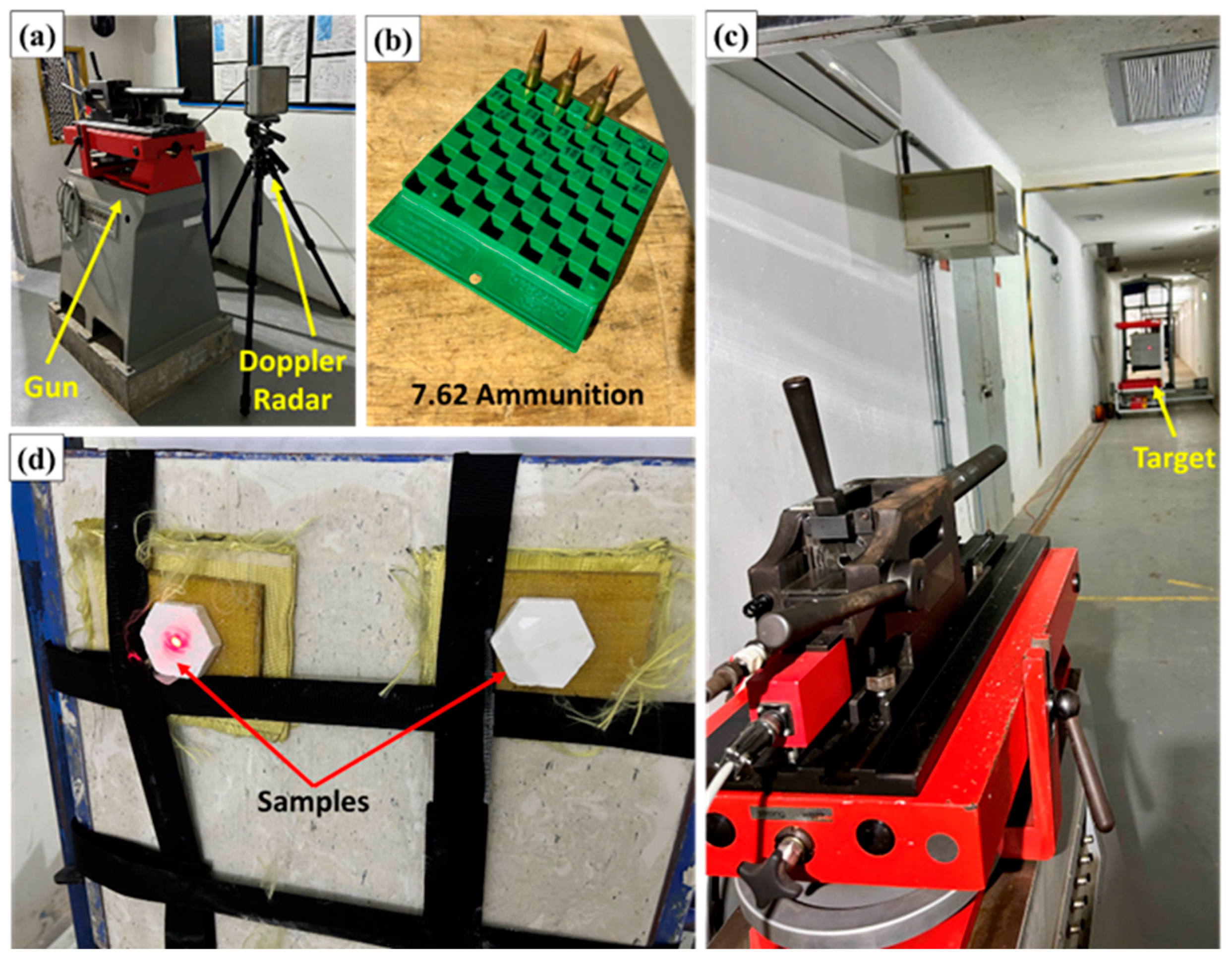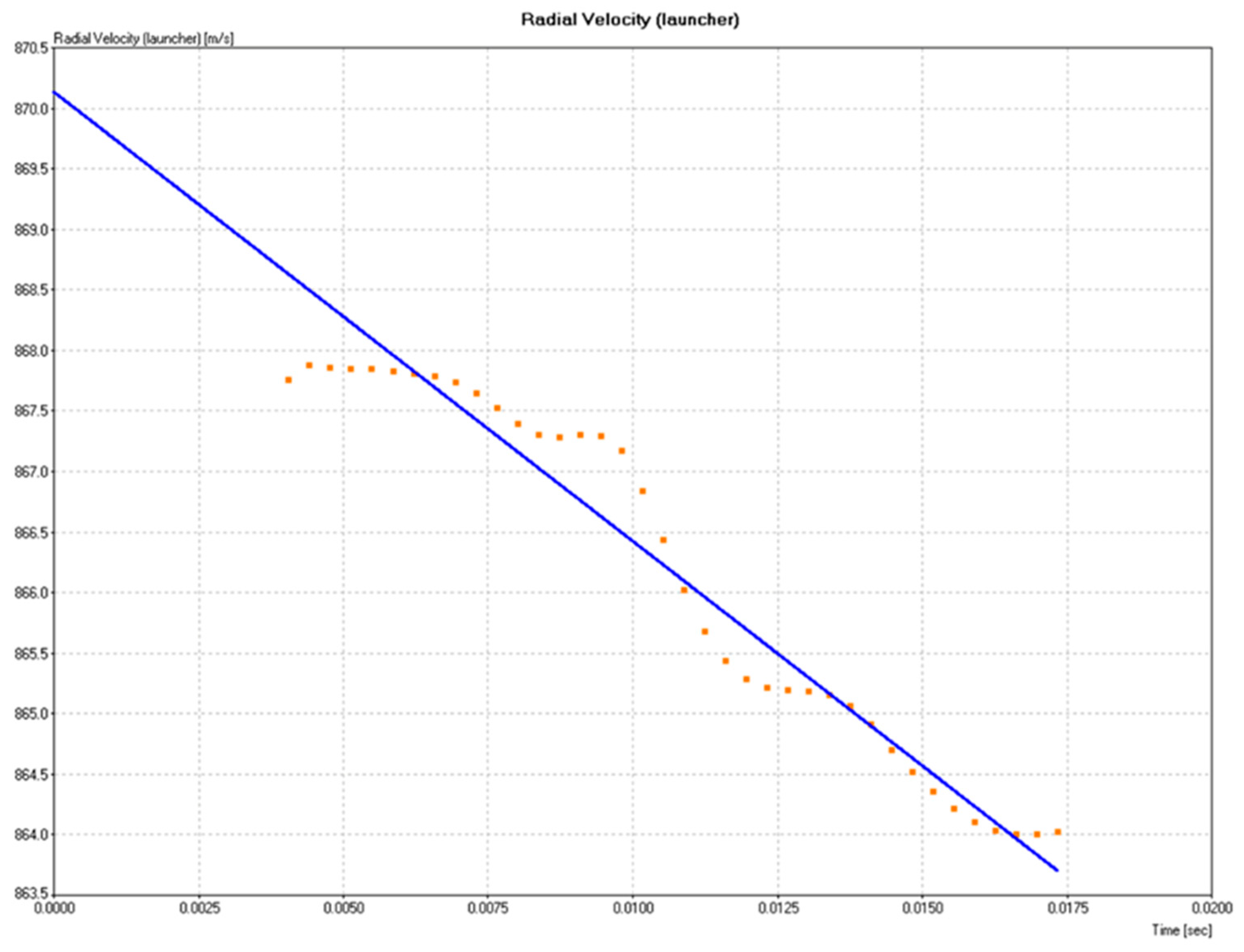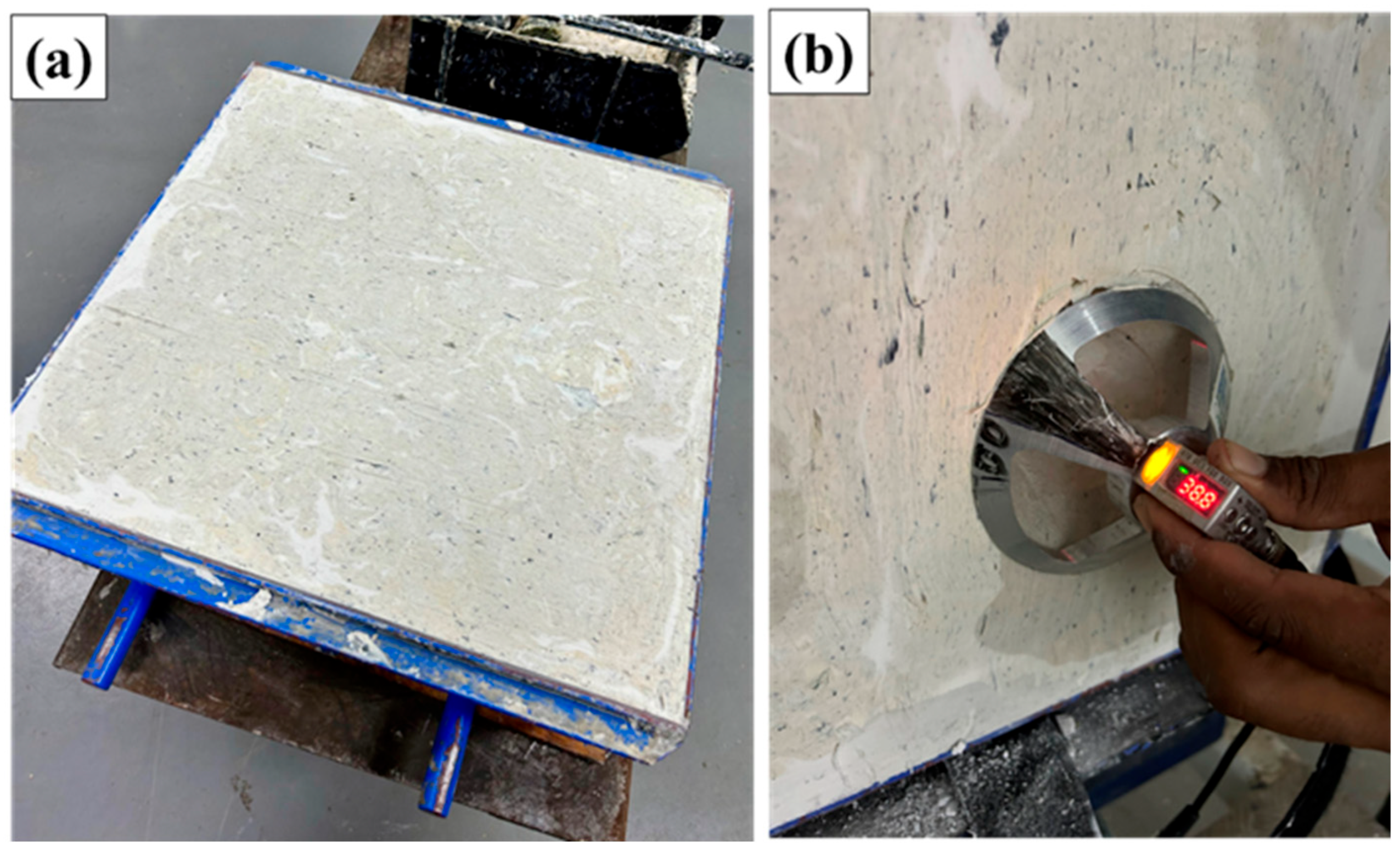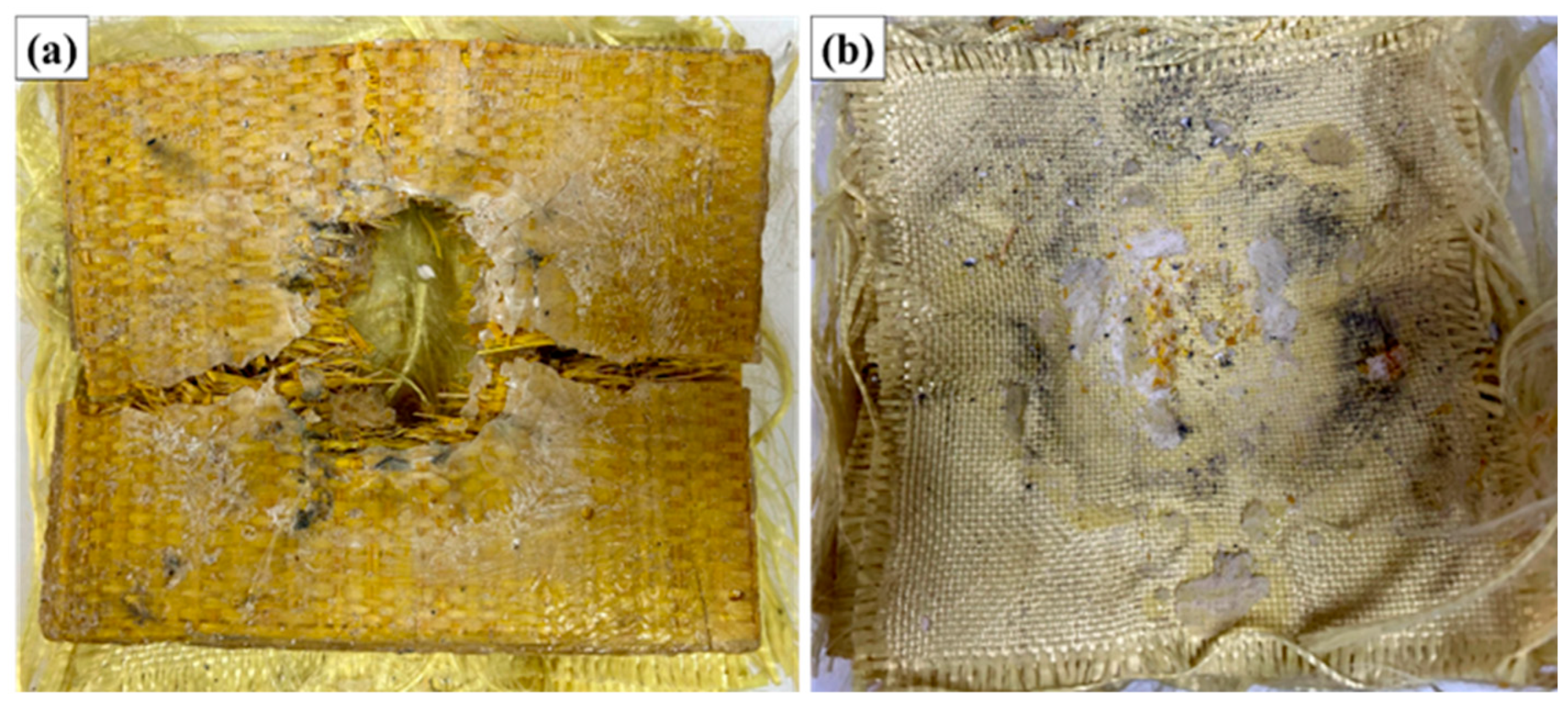3.1. Back-Face Signature (BFS) Depth Testing of the Multilayered Armor System (MAS)
The BFS evaluations sought to determine the viability of employing epoxy–raffia composites as an intermediary layer in an MAS. The trauma results acquired following ballistic impact for the assessed MAS are shown in
Table 2. As the three laminates have the same geometry and weave, no visible differences are expected in the macro photographs (
Figure 2); therefore, areal density and thickness are reported and used to distinguish the ER10/ER20/ER30 conditions, alongside their BFS outcomes.
Table 2 presents the results obtained in the ballistic test with measurement of residual trauma, quantified by the indentation depth in ballistic clay, for epoxy matrix composites reinforced with raffia fabric in the proportions of 10% (ER10), 20% (ER20), and 30% (ER30). This test followed the requirements established by the NIJ 0101.06 standard, which establishes that the maximum acceptable depth of deformation in the ballistic simulant (ballistic clay) is 44 mm, above which the armor is considered ineffective, regardless of the occurrence of perforation.
It can be observed that the ER10 composite (10% raffia) presented satisfactory performance, with an average indentation depth of 38.34 mm and a standard deviation of 0.29 mm, remaining below the established limit. This result demonstrates high efficiency in dissipating the kinetic energy of the projectile, ensuring adequate protection against residual trauma. The low dispersion of the results also suggests good uniformity in the distribution of the fibers and adequate matrix-fiber interfacial adhesion in this condition. This superior trauma control at 10 vol% is consistent with the energy-dissipative failure mechanisms observed in SEM (fiber pull-out with fibrillation, mixed-mode matrix fracture, and resin tags), whereas higher fractions trend toward delamination-dominated and plugging responses (see
Section 3.3).
In contrast, the ER20 composite (20% raffia) had an average depth of 46.82 mm, with a standard deviation of 1.73 mm, significantly exceeding the normative limit. This result shows that, for this fiber proportion, the material does not meet the ballistic performance criteria for trauma control. The increase in both the average and variability of the indentation values suggests the formation of internal defects, such as voids and poor impregnation, in addition to fragility at the matrix-fiber interface. These factors compromise the structural integrity of the laminate, favoring delamination and interlaminar failure modes under high-velocity impact.
The ER30 composite (30% raffia) showed the worst performance among the evaluated groups, with an average depth of 58.40 mm and a standard deviation of 0.63 mm. This result demonstrates that, in this condition, the increase in the volumetric fraction of fibers severely compromises the material’s ability to dissipate ballistic energy. The excessive accumulation of fibers, combined with the low wettability and interfacial compatibility with the epoxy matrix, results in the generation of high stress concentrations, which are insufficiently distributed, culminating in localized failures and a significant increase in deformation in the soft tissue simulant.
In general, there is a clear tendency for ballistic performance to decrease in terms of residual trauma control with the increase in the volumetric fraction of raffia fabric. This behavior is consistent with the specialized literature, which indicates that natural composites, when not subjected to interfacial compatibility treatments or when processed with high fiber contents, tend to present greater void formation, deficiencies in impregnation, and increased delamination mechanisms, all of which are detrimental to the efficiency in absorbing ballistic impact energy.
The disproportionate increase in BFS from 20% to 30% raffia is consistent with a transition from a “well-wetted, fiber-assisted” regime to a resin-starved, void-susceptible regime. At higher Vf, the reduced free resin limits matrix crack-bridging and stress redistribution, while tighter bundle packing/percolation promotes inter-bundle debonding and early interlaminar shear. Incomplete wet-out at ER30 increases the size/connectivity of voids that act as stress concentrators, facilitating matrix cleavage and delamination. Concomitantly, the stiffness–mass mismatch among the ceramic front, the raffia/epoxy layer, and the textile backing escalates, magnifying through-thickness shear and favoring plugging-type failure rather than controlled fiber pull-out/sliding. This shift in failure mode explains the sharp rise in trauma depth between ER20 and ER30 and is consistent with the macroscopic damage patterns in Figures 8 and 9 and the interfacial features visible in Figure 10.
Therefore, the ER10 composite is the only material approved according to the criteria of the NIJ 0101.06 standard for ballistic trauma control, while ER20 and ER30, although they have resisted perforation, do not meet the safety requirements related to the dissipation of impact energy, being considered unsuitable for ballistic applications without the adoption of modifications in the formulation or in the manufacturing process.
The graph presented in
Figure 5 shows the variation in the radial velocity of the projectile as a function of time during the ballistic test carried out with the ER10 composite, which contains 10% by volume of raffia fabric as reinforcement in an epoxy matrix. For clarity, the “radial velocity” reported here is the Doppler radar line-of-sight component of the projectile speed (
); due to coaxial alignment,
effectively represents the projectile speed in our experiments (see
Section 2.2.4).
The initial velocity recorded was approximately 870 m/s, a value consistent with high-caliber ammunition (7.62 mm) used in armor testing. The blue curve represents the expected linear trend for projectile deceleration in an idealized system, while the orange points correspond to the experimental data obtained during impact.
It can be seen that, in the first instants (up to approximately 0.007 s), the data remain almost constant, which indicates the initial penetration phase, in which the projectile breaks through the frontal ceramic layer of the multilayer system. From approximately 0.010 s onwards, the data show a sharp linear drop, demonstrating that the projectile began to decelerate significantly after interacting with the second layer of the armor, composed of the ER10 composite. This region corresponds to the action of the reinforced polymeric material, whose main function is to absorb energy and contain fragments after the initial impact.
The continuous deceleration observed to approximately 864 m/s, over approximately 0.017 s, demonstrates the ability of the ER10 composite to dissipate kinetic energy efficiently. This characteristic, combined with the trauma depth measured in ballistic clay below the 44 mm limit stipulated by NIJ 0101.06, confirms that the composite with 10% raffia offers satisfactory ballistic performance. Therefore, the data reinforce the viability of using ER10 as a sustainable replacement for Kevlar™ in light armor applications, both from a mechanical and regulatory standpoint.
In our coaxial setup, the Doppler-measured radial velocity
effectively equals the projectile speed. The slope of the
curve (negative
) is the deceleration imposed by the target; via Newton’s second law, the corresponding resisting force is
. The energy absorbed by the multilayer system during transit follows the work–energy relation,
Consequently, a steeper and longer deceleration segment and a lower exit
denote greater energy dissipation by the ceramic/intermediate/textile layers and typically correspond to smaller BFS. The ER10 record in
Figure 5 illustrates this behavior, consistent with its NIJ-compliant trauma depth.
The epoxy composite reinforced with raffia fabric at a volume fraction of 10% (ER10) showed satisfactory ballistic performance, meeting the indentation depth limit established by NIJ 0101.06 (≤44 mm), which demonstrates its viability as a functional material in the second layer of multilayer armor systems (MAS), traditionally occupied by synthetic fiber laminates such as Kevlar™. Based on this result, it is possible to point out specific practical applications for the developed material, such as its use in personal ballistic vests intended for military or police use, where it can be incorporated between the frontal ceramic layer (Al2O3/Nb2O5) and the interface with the user’s body.
Furthermore, the ER10 composite can be applied in modular protection panels for light armored vehicle cabins, in replaceable ballistic plates (trauma plates) attached to flexible vests, and in civil protection devices such as backpacks and safety cases. The performance of ER10 as a projectile residual energy dissipator makes it particularly promising in applications that require lightness, ballistic efficiency, and sustainability. Additionally, its use can be extended to experimental tests and academic developments as a reference for lignocellulosic composites in comparative studies of replacing synthetic fibers with natural ones.
From an industrial point of view, some important limitations can be identified in this work. The first concerns the reproducibility and uniformity of the composite reinforced with raffia fabric, since natural fibers present intrinsic variations in their morphology, chemical composition (cellulose, lignin, and hemicellulose contents), and mechanical properties, which can compromise large-scale quality control. To mitigate this limitation, it is recommended to standardize the fibers through surface treatments (such as controlled alkalization) and prior selection based on morphometric and structural criteria, in addition to the implementation of rigorous protocols for traceability of origin and processing.
Another limitation is the interfacial adhesion between the epoxy matrix and the raffia fabric, especially in composites with higher fiber content (ER20 and ER30), where failures such as delamination and fiber pullout were observed. To overcome this challenge, chemical modifications to the fibers, such as silanization or the use of compatibilizers, can be applied, as well as adjustment of the polymer matrix formulation to improve chemical affinity and load transfer between the constituents.
From an industrial processing perspective, the manual rolling used in this research is limited in terms of automation and reproducibility. To overcome this limitation, the development of production routes compatible with industrial techniques such as hot rolling, compression molding, or vacuum infusion would be a necessary step.
Table 3 compares the depth of trauma (BFS—Backface Signature) in different epoxy composites reinforced with natural fibers after ballistic testing, using as a reference the limit of 44 mm established by NIJ 0101.06, above which the level of protection is considered insufficient, even without projectile perforation.
The composites reinforced with raffia fabric (ER10, ER20, and ER30) presented different performances according to the volume fraction of fiber used. The ER10 composite, with 10% raffia, presented an average depth of 38.34 ± 0.29 mm, being below the critical limit and, therefore, demonstrating satisfactory ballistic performance. This behavior can be attributed to a better impregnation of the epoxy matrix in the raffia fabric, allowing a more efficient energy dissipation. However, as the fiber content increases to 20% (ER20) and 30% (ER30), the BFS values increase to 46.82 ± 1.73 mm and 58.40 ± 0.63 mm, respectively, exceeding the limit value and indicating loss of ballistic performance. This behavior may be related to poor fiber distribution, agglomerations, and deficiencies in interfacial adhesion, which compromise the structural integrity and impact absorption capacity of the composites.
On the other hand, the composites reinforced with carnauba fibers (EC20, EC30, and EC40) presented superior performance. All BFS values were below 44 mm, with emphasis on EC40 (31.20 ± 2.90 mm), which presented the smallest depth within this group. The observed trend indicates that, in this case, the increase in fiber concentration did not compromise performance, possibly due to the greater rigidity of the carnauba fibers and their good compatibility with the epoxy matrix, resulting in greater efficiency in dissipating impact energy.
The composites with titica vine fibers (ETVF20 and ETVF40) presented the best results among all the materials analyzed, with average values of 25.57 ± 2.89 mm and 32.51 ± 4.98 mm, respectively. These values demonstrate excellent resistance to ballistic trauma, suggesting that these fibers have high tenacity and a structure favorable to energy dissipation, even with higher reinforcement contents.
In general, the ballistic performance sequence, based on strictly ascending BFS values (lower is better), is: ETVF20 < EC40 < ETVF40 < EC30 < EC20 < ER10 < ER20 < ER30. These results show that the type of fiber used exerts a significant influence on the impact response, and that increasing the volume fraction is not always associated with improved performance. In addition to the aspect ratio, factors such as fiber morphology, interfacial adhesion, and distribution in the matrix must be carefully optimized. Titica vine and carnauba fibers have shown great promise for application in multilayer armor systems, while raffia, despite its good performance at low concentrations, requires strict control of the formulation to ensure its effectiveness.
To make the literature comparison explicit, we quantify the differences in BFS relative to epoxy composites reinforced with carnauba fibers (EC20/EC30/EC40) and titica vine fibers (ETVF20/ETVF40) reported under comparable NIJ conditions. The ER10 laminate (38.34 mm) is higher than EC20/EC30/EC40 (34.90/32.80/31.20 mm) by +9.90%/+16.90%/+22.90%, and higher than ETVF20/ETVF40 (25.57/32.51 mm) by +49.90%/+17.90%, respectively. While ER10 remains NIJ-compliant (≤44 mm), ER20 and ER30 exceed the limit, unlike the cited EC/ETVF systems. These quantitative gaps are consistent with microstructural factors discussed in
Section 3.3 (fiber morphology, wet-out, and interfacial adhesion), suggesting that raffia’s performance is competitive only at a lower volume fraction (10 vol%), where controlled pull-out and interfacial sliding occur without excessive voids/delamination. From an application standpoint, raffia laminates are therefore promising as hybrid/sacrificial intermediate layers to balance sustainability and cost with trauma control.
The lower ballistic efficiency of raffia/epoxy compared with carnauba- and titica-reinforced epoxies appears to be multi-factorial. First, bundle morphology and linear density: raffia bundles are typically wider and less uniform, which at higher Vf increases resin-starved contacts and fosters void connectivity, reducing crack-bridging and stress redistribution. Second, fiber–matrix interface: our raffia fabric was used without surface treatment, and SEM reveals interfacial gaps and extensive pull-out, consistent with weaker adhesion than reported for the carnauba/titica systems under comparable epoxy matrices (
Table 3). Third, hygroscopicity and surface chemistry (lignocellulosic constituents) may locally plasticize the interface, further lowering shear transfer during impact. Fourth, weave/crimp effects: the raffia fabric’s crimp and yarn packing can reduce in-plane stiffness and magnify through-thickness shear, favoring delamination. Taken together, these factors promote a failure-mode shift, from controlled pull-out/sliding (energy-dissipative) to matrix cleavage + interlaminar delamination + plugging, which explains the larger BFS observed for raffia, especially at 30 vol%.
For reference, multilayered armor systems incorporating aramid laminates (Kevlar™) or ultra-high molecular weight polyethylene (UHMWPE) as the intermediate layer typically present backface signature (BFS) values between 25 and 35 mm under NIJ Level III conditions [
18,
21,
22]. Although the raffia-reinforced epoxy composites developed in this study did not reach BFS values as low as these advanced synthetics, the ER10 configuration (38.34 ± 0.29 mm) successfully remained within the NIJ 0101.06 safety threshold (≤44 mm), confirming its functional ballistic performance. Importantly, raffia-based laminates exhibit an average density of ~1.10 g/cm
3, lower than that of Kevlar™ (1.44 g/cm
3) and comparable to UHMWPE (0.97 g/cm
3), highlighting their potential in lightweight applications. Considering that reduced mass translates directly into improved comfort and mobility for users, the lower density and cost of raffia composites add practical advantages to their performance. Beyond weight considerations, raffia also offers a distinct sustainability advantage: it is a renewable, biodegradable, and locally available natural resource in tropical regions, fostering regional bioeconomy development while reducing dependence on expensive, imported aramid fabrics. From an application standpoint, raffia composites may be employed not as a full replacement of synthetics but as hybrid or sacrificial layers in MAS configurations, acting synergistically with Kevlar™ or UHMWPE to balance impact resistance, weight reduction, cost-effectiveness, and environmental responsibility. This balance between technical feasibility, sustainability, and socioeconomic impact strengthens the case for raffia as a promising candidate for next-generation eco-friendly ballistic systems.
3.3. Fracture Surface Analysis
Figure 6 illustrates the ballistic impact test performed on the composites.
For ER10, individual BFS values ranged from 38.00 to 38.80 mm (
Table 2), with a mean of 38.34 ± 0.29 mm (
Table 3), all of which were below the NIJ 0101.06 limit of 44 mm. This result demonstrates that the composite presented sufficient energy absorption capacity to reduce impact transfer to the support material (ballistic clay), remaining within the limit considered safe to avoid lethal risk from internal trauma.
Figure 7 illustrates the appearance of the MAS with 10% fiber volume (ER10) after ballistic testing with 7.62 mm ammunition.
Analysis of the images obtained after the ballistic test shows that the ER10 composite panel suffered localized damage in the impact region, with evident fracture of the epoxy matrix and partial rupture of the raffia fabric. Radial cracks and delaminations were observed around the impact zone, typical of energy dissipation mechanisms in laminated composites. Despite the presence of fractures in the matrix and natural fiber network, the structural integrity of the plate was maintained. There was no complete perforation of the armor, and the aramid fabric on the back face remained functional, contributing to the containment of projectile fragments and limiting damage.
Furthermore, the measurement of the indentation depth in the ballistic clay revealed average values lower than 44 mm, meeting the criteria established by the NIJ 0101.06 standard. Therefore, the performance of the ER10 composite can be classified as satisfactory with regard to ballistic protection against 7.62 mm caliber projectiles, within the parameters evaluated. From a macroscopic point of view, the energy absorption mechanisms were predominantly: rupture of the raffia fibers by shear and traction, brittle fracture of the polymer matrix, delamination between the composite layers, and energy absorption in the aramid fabric layer at the back of the armor system. These mechanisms, acting synergistically, allowed the dissipation of the kinetic energy of the projectile, resulting in the preservation of the integrity of the armor and trauma levels within the limits acceptable for user safety.
Figure 8 illustrates the appearance of the MAS with 20% fiber volume (ER20) after ballistic testing with 7.62 mm ammunition.
Figure 8.
Appearance of the MAS with 20% fiber volume (ER20) after ballistic testing with 7.62 mm ammunition: (a) impact face; (b) internal face.
Figure 8.
Appearance of the MAS with 20% fiber volume (ER20) after ballistic testing with 7.62 mm ammunition: (a) impact face; (b) internal face.
Visual inspection of sample ER20 after ballistic testing reveals a high level of structural damage, characterized by extensive fracture of the polymer matrix, evident delamination, and rupture of the raffia fibers in the central region of the impact. The formation of a predominantly radial fracture is clearly observed, starting from the point of impact, which propagates in a pronounced manner along the fabric, indicating intense interlaminar failure. The presence of large longitudinal and transverse cracks suggests that the energy dissipation mechanism was strongly associated with crack propagation in the matrix, delamination between layers, and fiber rupture. In addition, it is possible to note a central opening, which corresponds to the site of maximum stress concentration, where there was significant detachment of the epoxy matrix, leaving the fibers partially exposed.
In the rear view of the sample (aramid side), the deformation of the system is still quite visible, but there is no evidence of complete perforation. This indicates that, despite the high level of damage in the intermediate layer (raffia/epoxy), the aramid fabric layer maintained its function of containing the fragments and the projectile, contributing decisively to the overall integrity of the multilayer system. The severity of the damage is directly correlated with the quantitative indentation result recorded on the ballistic clay (average of 46.82 mm), which exceeds the maximum limit of 44 mm established by NIJ 0101.06, classifying the ballistic performance of the ER20 configuration as unsatisfactory for the safety parameters established for trauma. This result suggests that the 20% volumetric fraction of raffia fabric was not sufficient to ensure adequate energy dissipation, with a significant loss of ballistic efficiency when compared to the behavior observed in the ER10 configuration.
Therefore, the macroscopic analysis reinforces the quantitative data obtained in the test, showing that, for this reinforcement proportion, there was an unfavorable combination between rigidity, toughness, and interfacial adhesion, which culminated in a more pronounced structural collapse of the system under ballistic impact.
Figure 9 illustrates the appearance of the MAS with 30% fiber volume (ER30) after ballistic testing with 7.62 mm ammunition.
Figure 9.
Appearance of the MAS with 30% fiber volume (ER30) after ballistic testing with 7.62 mm ammunition: (a) impact face; (b) internal face.
Figure 9.
Appearance of the MAS with 30% fiber volume (ER30) after ballistic testing with 7.62 mm ammunition: (a) impact face; (b) internal face.
Visual evaluation of the ER30 samples after ballistic testing revealed extensive localized damage in the impact region, characterized by significant fracture of the epoxy matrix and marked delamination of the raffia fabric layers. Complete rupture of the front layer of the armor is clearly observed, evidenced by the propagation of radial cracks and the removal of matrix fragments in the central region, typical of failure mechanisms associated with brittle fracture of the resin combined with tensional rupture of the fibers.
Furthermore, analysis of the rear face (side in contact with the ballistic clay) shows accumulation of debris and evident textile deformation in the layers of aramid fabric, corroborating that there was a significant transfer of kinetic energy to this region. The presence of abrasion marks, burned regions, and textile collapse zones indicates that the projectile transferred high energy to the structure, resulting in progressive failures.
The failure pattern is characterized by a predominantly plugging type of failure, with expulsion of material in the central region, combined with fiber pull-out mechanisms, interlaminar fracture (delamination), and transverse rupture of the raffia fibers. This condition is particularly noticeable by the exposure of broken and misaligned fibers, in addition to the presence of a well-defined circular central cavity.
However, unlike the ER10 conditions, which maintained structural integrity and presented indentation below the critical limit of the NIJ 0101.06 standard (44 mm), and even the ER20 condition, which presented intermediate behavior, the ER30 condition presented critical failure in both the front and intermediate layers, failing to adequately dissipate the impact energy, as evidenced by the high indentation depth in the ballistic clay (58.4 mm).
This result suggests that an excessive increase in the volumetric content of raffia fabric compromises the ability of the epoxy matrix to effectively transfer and dissipate projectile energy, leading to a more fragile structure that is susceptible to catastrophic fracture. This behavior may be related to the increase in void content, poor impregnation of the matrix, reduction in the overall toughness of the system, and loss of adhesion at the fiber/matrix interface, factors that are recurrent in composites with a high content of fibers of natural origin.
Prior to ballistic testing, scanning electron microscopy (SEM) was carried out on untested raffia/epoxy laminates to establish baseline microstructural features. The ER10 composite exhibited well-impregnated raffia bundles with minimal voids and close contact between the fibrillated raffia surfaces and the epoxy matrix. The rough, microfibrillated morphology of the raffia fibers favored mechanical interlocking and partial wetting by the resin, promoting frictional sliding and energy dissipation during impact. In contrast, ER20 and ER30 laminates displayed localized voids, incomplete wetting, and resin-starved regions between dense raffia bundles—defects that limit interfacial adhesion and load transfer. These as-fabricated microstructural differences are consistent with the observed increase in BFS values and the greater variability for higher fiber fractions. Additional pre-impact morphological details for these materials can be found in Silva et al. [
19] and [
25], which complement the baseline characterization presented here.
After ballistic impact, SEM observations revealed significant morphological evolution. The impacted ER10 surface showed extensive fiber pull-out, progressive interfacial debonding, and resin tags adhering to fiber surfaces—features indicative of controlled frictional energy dissipation. In ER20 and ER30, the dominant mechanisms shifted toward matrix cleavage, interlaminar delamination, and localized fiber rupture, reflecting insufficient interfacial adhesion and a transition from controlled pull-out to catastrophic separation. Comparison between pre- and post-impact morphologies thus confirms that the fiber–matrix interface plays a decisive role in the ballistic response: a well-wetted, moderately reinforced laminate (ER10) promotes distributed microcracking and efficient frictional energy absorption, whereas excess fiber content leads to void coalescence, delamination, and reduced ballistic efficiency. These results establish a clear structure–property relationship linking microstructural integrity to trauma depth, reinforcing the importance of optimized impregnation and interface quality for high-velocity impact applications.
Figure 10 shows the SEM micrographs of the MAS with 10% raffia fabric.
SEM micrographs of the raffia fabric-reinforced epoxy composite (ER10), obtained at different magnifications (100× and 2400×), reveal a complex microstructure that directly influences its ballistic performance. Fibrillated raffia fiber bundles and rough surfaces are observed, which favor mechanical anchoring and promote additional energy dissipation mechanisms, such as fiber pull-out and progressive interfacial detachment. The epoxy matrix exhibits brittle fracture regions, with smooth surfaces alternating with rough zones associated with shear, characterizing a hybrid failure mechanism.
The SEM features in ER10 (
Figure 10) indicate a failure mode that is favorable for energy dissipation: (i) extensive fiber pull-out with visible fibrillation and long sliding paths; (ii) rough matrix fracture with shear lips and hackle marks, consistent with mixed-mode cracking rather than pure cleavage; and (iii) resin tags/imprints on fiber surfaces, evidencing partial adhesion followed by controlled debonding. Together with the limited void content and adequate wet-out at 10 vol%, these features maximize frictional sliding, crack deflection, and crack-bridging, thus reducing BFS. In contrast, the macroscopic response of ER20/ER30 (
Figure 8 and
Figure 9) is dominated by continuous delamination planes, plugging-type material removal, and powdery matrix cleavage, which are typical of resin-starved and inter-bundle debonding regimes. Such regimes shorten sliding distances, diminish frictional work, and concentrate through-thickness shear mechanisms that explain the higher trauma depths for 20% and 30% compared to 10%.
Figure 10.
SEM micrographs of the MAS with raffia fabric (ER10): (a) 100× magnification; (b) 2400× magnification.
Figure 10.
SEM micrographs of the MAS with raffia fabric (ER10): (a) 100× magnification; (b) 2400× magnification.
Although the present work did not experimentally evaluate processing modifications, the SEM observations suggest that some strategies, such as vacuum-assisted impregnation, mild alkaline or silane surface treatments, and post-curing optimization, could be explored in future studies to mitigate porosity and improve fiber–matrix adhesion. These approaches are therefore proposed as prospective methods for further improving interfacial uniformity and structural reliability, rather than as confirmed results of this investigation.
The microstructural examination revealed a complex and heterogeneous morphology in the raffia-reinforced laminates. At lower magnifications, extensive fiber pull-out regions and interfacial gaps were observed, suggesting localized decohesion between the raffia bundles and the epoxy matrix during high-velocity impact. These voids are indicative of interfacial delamination mechanisms, which contribute to energy dissipation by frictional sliding and progressive fiber debonding. Higher magnification images showed broken raffia fibrils with tapered ends and evidence of fibrillation, confirming that tensile and shear rupture as predominant failure modes. The rough fracture surfaces of the epoxy matrix surrounding the fibers suggest a mixed-mode fracture behavior, combining brittle matrix cracking and ductile deformation near the fiber–matrix interface. Additionally, resin-rich areas and partially wetted fiber surfaces denote regions of incomplete impregnation, consistent with the observed decrease in ballistic efficiency for higher fiber fractions (ER20 and ER30). These observations corroborate the macroscopic findings, demonstrating that optimized fiber wetting and controlled interfacial adhesion are essential for maximizing energy absorption and maintaining laminate integrity under ballistic impact.
